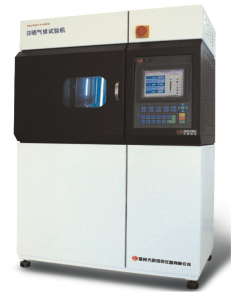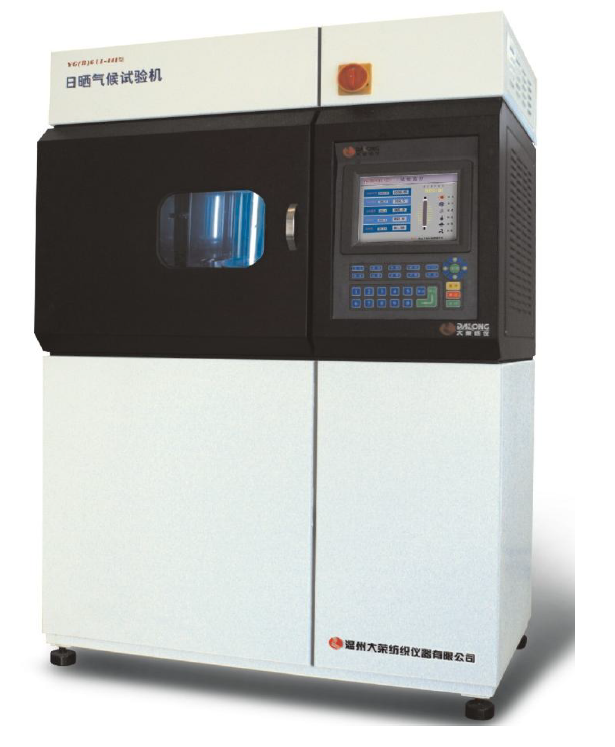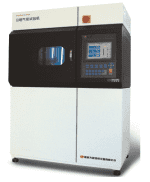Xenon Arc Light Fastness Tester
Xenon Arc Light Fastness Tester is a laboratory instrument used to evaluate the color fastness of textiles and materials when exposed to sunlight or artificial light. It simulates full-spectrum sunlight using a xenon arc lamp, making it ideal for assessing how materials resist fading over time.
Purpose of Xenon Arc Light Fastness Tester:
To determine how well a fabric or material maintains its color and integrity under prolonged light exposure, especially for outdoor or light-sensitive applications.
Working Principle of Xenon Arc Light Fastness Tester :
A xenon arc lamp emits light similar to natural sunlight. Fabric samples are exposed under controlled temperature, humidity, and light intensity. The degree of fading is compared to standard blue wool scales to assign a light fastness rating.
Main Components Xenon Arc Light Fastness Tester :
– Xenon Arc Lamp: Simulates sunlight (UV, visible, and infrared).
– Sample Holder: Rotates samples for uniform exposure.
– Environmental Controls: Maintains specific temperature and humidity.
– Control Panel/Software: Sets test parameters (light, time, humidity, etc.).
– Filters: Control the light spectrum (e.g., daylight, window glass).
Applications:
– Textiles
– Automotive interiors
– Plastics, paints, and coatings
– Outdoor fabrics and furnishings
Benefits of Xenon Arc Light Fastness Tester:
- Realistic Sunlight Simulation – Accurately mimics full-spectrum natural sunlight, including UV, for reliable light fastness testing.
- Standard Compliance – Meets international standards like ISO 105-B02, AATCC TM16, and ASTM G155, ensuring globally accepted results.
- Improves Product Durability – Helps manufacturers assess and improve resistance to color fading, cracking, or degradation from light exposure.
- Versatile Applications – Suitable for testing textiles, plastics, paints, leather, and coatings.
- Controlled Test Conditions – Offers precise control over temperature, humidity, and light intensity, improving test consistency and repeatability.
- Supports Quality Assurance – Detects early failures in colorfastness, enabling better product design and material selection.
- Automated Operation – Programmable tests and automatic monitoring reduce operator involvement and errors.
- Accelerated Testing – Speeds up evaluation by simulating months or years of sun exposure in a few days or weeks.
Features of Xenon Arc Light Fastness Tester:
- Xenon Arc Lamp – Provides full-spectrum light (UV, visible, IR) to simulate natural sunlight accurately.
- Programmable Control System – Digital or touchscreen interface for setting test parameters like exposure time, temperature, humidity, and irradiance.
- Humidity and Temperature Control – Maintains precise environmental conditions inside the test chamber.
- Rotating Sample Carousel – Ensures uniform light exposure on all test specimens.
- Light Spectrum Filters- Adjustable filters simulate different light conditions (e.g., daylight, window glass, outdoor).
- Standards Compliance- Meets ISO, AATCC, ASTM, and other global test methods for light fastness.
- Automatic Irradiance Control – Maintains constant light intensity throughout testing, improving accuracy.
- Safety Features – Includes overheating protection, door interlock, and lamp monitoring system.
- Data Logging and Export – Some models offer USB or software integration for saving and analyzing test data.
- Durable and Insulated Chamber – Built with high-quality materials for stable testing and long-term use.
How to Use Xenon Arc Light Fastness Tester:
- Prepare the Samples
– Cut fabric or material into standard-size specimens.
– Label and condition samples (usually 24 hrs at 21°C, 65% RH).
- Mount the Samples – Attach samples onto holders or clips, placing them evenly on the rotating drum or carousel.
- Insert Blue Wool Standards- Include standard blue wool reference fabrics to compare light fastness.
- Set Test Parameters
– Use the control panel to set:
– Irradiance (e.g., 0.35 W/m² at 420 nm)
– Temperature and humidity
– Test duration (e.g., 24–72 hrs or more)
- Start the Test – Close the chamber door and begin the exposure cycle.
- Monitor Progress- System auto-adjusts irradiance and logs test conditions. Periodically check if needed.
- End and Remove Samples – After completion, stop the test and remove the samples and blue wool references.
- Evaluate Results – Compare the sample fading to the blue wool scale to assign a light fastness rating (1–8 scale).
Xenon Arc Light Fastness Tester
[Scope of application]
It is used for the light fastness and weather fastness test in the color fastness test. It
can also be used for the light fastness test and light fastness test of paints,
pigments, coatings, rubber, plastics, wood floors, paper and other materials. Aging
test.
Related Standards of Xenon Arc Light Fastness Tester
GB/T8427 (China National Standard Drafting Unit)
GB/T15102-2006 GB/T14576 GB/T15104-2006 GB/T8430 AATCC TM16 ISO105-B04
ISO105-B02 etc.
Instrument characteristics of Xenon Arc Light Fastness Tester
1. Digital setting of light intensity, real-time monitoring, and automatic adjustment
to meet the stability requirements of different standards for test light sources
(420nm can be switched; 300-800nm or 300-400nm band monitoring);
2. Standard Blackboard Thermometer (BST) and Blackboard Thermometer (BPT)
can be selected for use, and are tested at the same station (equal distance) as the
sample, which truly reflects the tested condition of the sample;
3. The measured data is processed by the CPU and displayed on the color screen in
the form of numbers, graphs, curves, etc., without stopping for observation;
4. Microchip’s 32-bit intelligent CPU, high-efficiency real-time control, to ensure
accurate reproduction of the same test environment;
5. 7-inch color screen display and control, multiple test monitoring modes
(animation, numbers, charts), convenient control, intuitive and clear;
6. All sample holders can be timed separately, and different samples can be tested
on the same machine, which is convenient for test monitoring and reduces
operating costs;
7. Rated 1500W long arc xenon lamp technology, high efficiency and energy saving,
real simulation of sunlight spectrum;
8. Industrial temperature control (refrigeration) system, rapid and stable
temperature adjustment in the test chamber;
9. Built-in self-circulation system and air filtration system, greatly reducing
environmental requirements;
10. European traceable spectrum analyzer, multi-measurement calibration;
11. Built-in network communication module, can customize the remote monitoring
function of mobile phone APP;
12. The instrument can be optionally equipped with thermal printout or data
export of test environment parameters;
13. The quality assurance that one test can run continuously for 1000 hours
[Technical Parameters]1. Temperature control range of test chamber: (20~50)℃; accuracy: ±2℃
2. Test chamber humidity control range: (15~95)%RH, accuracy: ±5%RH
3. Test time control range: 0~9999:59 (h:min); accuracy: ±1min
4. Irradiance control range:
(0.80~1.60)W/m2/420nm Accuracy: ±0.02W/m2/420nm
(25-60)W/m2/300-400nm Accuracy: ±2W/m2/420nm
(300-650)W/m2/300-800nm Accuracy: ±10W/m2/420nm
Digital setting, automatic compensation
Xenon light source:
a. Rated power of xenon arc lamp: 1.5kW;
b. Color temperature: 5500K~6500K;
6. Sample:
a. Rotation speed of sample holder: 5rpm
b. Diameter of sample holder distribution: 286mm
c. The size and number of sample holders that can be installed:
GB standards AATCC(Optional)
Specimen clamp size
203mm×
48mm
220mm×92mm
Maximum sample size
135mm×
45mm
150mm×90mm
Maximum exposure area
118mm×
33mm
130mm×50mm
Maximum number of
pieces
13
6
d. Timing of each sample holder separately: range: 0~9999:59 (h: min); accuracy: ±
1min
e. Sample thickness: ≤3mm
7. Standard Blackboard Thermometer (BST) range:
(20~75)℃; Resolution: 0.1℃, Accuracy: ±2℃
Or optional blackboard temperature (BPT) range:
(25~80)℃, resolution: 0.1℃, accuracy: ±2℃
8.7 inch touch screen operation
9. Stand-alone with thermal printer (optional)
10. Power supply: AC220V±10% 50Hz 3.5kW
11. Dimensions: 1130mm×760mm×1895mm
12.Weight: about 380kg
(Note: The equipment test conforms to the standard based on the above basic
configuration and parameters. If it involves other standards and the test exceeds
the above technical content, please contact our company for special
customization)
(Note: The equipment test conforms to the standard based on the above basic
configuration and parameters. If it involves other standards and the test exceeds
the above technical content, please contact our company for special
customization)



 Products
Products
 Martindale abrasion tester Updated
Martindale abrasion tester Updated












 r Permeability Tester
Appliance Range
It is used to TEST the air permeability of various textile fabrics, including industrial fabrics, nonwoven fabrics and other textile products and other breathable materials.
Related Standards
GB / T 5453, GB / T 13764, ISO 9237, ISO 5636, ASTM D737, etc.
Instrument characteristics
1. Automatic sample clamping, automatic nozzle replacement, and quick test.
2. Microcomputer processing, the test results are displayed directly, without manual table calculation;
3. Built-in continuous test mode, the test unit can be switched as needed.
4. Chinese LCD menu operation, configure computer interface.
Technical parameter
1. Range of sample pressure difference: 1 ~ 4000Pa
2. Measurable air permeability: 1 ~ 40,000mm / s
3. Measurement error: ≤ ± 2%
4. Measurable fabric thickness: ≤8mm
5. Test area: 5cm2; 20cm2; 50cm2; 100cm2
Ф50mm (≈19.6cm2)
Ф70mm (≈38.5cm2)
6. Nozzles: 11 in total (automatic replacement of digital setting)
CODE 00 01 02 03 04 05 06 07 08 09 10
DIAφ(mm)
0.8 1.2 2 3 4 6 8 10 12 16 20
7.Data Capacity:≤200 times tests
8.Power Supply:AC220V 50Hz 2KW
9.Weight:80Kg
10.Shape:1250×700×1250mm
r Permeability Tester
Appliance Range
It is used to TEST the air permeability of various textile fabrics, including industrial fabrics, nonwoven fabrics and other textile products and other breathable materials.
Related Standards
GB / T 5453, GB / T 13764, ISO 9237, ISO 5636, ASTM D737, etc.
Instrument characteristics
1. Automatic sample clamping, automatic nozzle replacement, and quick test.
2. Microcomputer processing, the test results are displayed directly, without manual table calculation;
3. Built-in continuous test mode, the test unit can be switched as needed.
4. Chinese LCD menu operation, configure computer interface.
Technical parameter
1. Range of sample pressure difference: 1 ~ 4000Pa
2. Measurable air permeability: 1 ~ 40,000mm / s
3. Measurement error: ≤ ± 2%
4. Measurable fabric thickness: ≤8mm
5. Test area: 5cm2; 20cm2; 50cm2; 100cm2
Ф50mm (≈19.6cm2)
Ф70mm (≈38.5cm2)
6. Nozzles: 11 in total (automatic replacement of digital setting)
CODE 00 01 02 03 04 05 06 07 08 09 10
DIAφ(mm)
0.8 1.2 2 3 4 6 8 10 12 16 20
7.Data Capacity:≤200 times tests
8.Power Supply:AC220V 50Hz 2KW
9.Weight:80Kg
10.Shape:1250×700×1250mm 




 Scope of application
It is used for the determination of the tear resistance of various woven
fabrics (Elmendorf method), and it can also be used for the determination
of the tear resistance of thick paper, plastic sheeting, electrical tape, etc.
Related standards
GB/T 3917.1 FZ/T60006 FZ/T75001 ISO1974/9290 ASTM D1424/5734
etc.
Instrument characteristics
1. Maximum 300N test range
2. Microcomputer control, digital decoding, support online
communication
3. Color touch screen control, Chinese and English menu operation
interface
4. Pneumatic clamping, automatic cutting
5. A variety of measurement units (cN, gf) selection
6. Fully automatic operation with safe operation protection.
7. Automatically increase potential energy
[Technical parameter]:
1. Test range: first gear: (0~16)N second gear: (0~32)N third gear: (0~
64)N fourth gear: (0~128)N fifth gear: (0~300)N
2. Test accuracy: ≤±0.2%F·S
3. Tearing length: 43mm (non-standard 30-60mm can be set)
4. Automatic incision length: (20±0.2)mm
5. Sample size: (100×63)mm
6. Specimen clamping: pneumatic way
7. Sample test: Up to 10 sets per group on the device side, and 30 sets
of data can be selected to be saved
8. Power supply: AC220V±10% 50Hz 100W
9. Dimensions: (650×660×680)mm
10. Weight: 50kg
[Sample of control interface]:(English version is also available.)
Scope of application
It is used for the determination of the tear resistance of various woven
fabrics (Elmendorf method), and it can also be used for the determination
of the tear resistance of thick paper, plastic sheeting, electrical tape, etc.
Related standards
GB/T 3917.1 FZ/T60006 FZ/T75001 ISO1974/9290 ASTM D1424/5734
etc.
Instrument characteristics
1. Maximum 300N test range
2. Microcomputer control, digital decoding, support online
communication
3. Color touch screen control, Chinese and English menu operation
interface
4. Pneumatic clamping, automatic cutting
5. A variety of measurement units (cN, gf) selection
6. Fully automatic operation with safe operation protection.
7. Automatically increase potential energy
[Technical parameter]:
1. Test range: first gear: (0~16)N second gear: (0~32)N third gear: (0~
64)N fourth gear: (0~128)N fifth gear: (0~300)N
2. Test accuracy: ≤±0.2%F·S
3. Tearing length: 43mm (non-standard 30-60mm can be set)
4. Automatic incision length: (20±0.2)mm
5. Sample size: (100×63)mm
6. Specimen clamping: pneumatic way
7. Sample test: Up to 10 sets per group on the device side, and 30 sets
of data can be selected to be saved
8. Power supply: AC220V±10% 50Hz 100W
9. Dimensions: (650×660×680)mm
10. Weight: 50kg
[Sample of control interface]:(English version is also available.) 



 VeriVide offers high-quality Colour Assessment Cabinets (CACs) such as the CAC 60-4, CAC 60-5, and CAC 120-4&5. These cabinets, originating from the UK, are reliable tools for visual evaluation in quality assurance, meeting national, international, and retailer standards. They effectively mitigate issues related to color assessment.
VeriVide offers high-quality Colour Assessment Cabinets (CACs) such as the CAC 60-4, CAC 60-5, and CAC 120-4&5. These cabinets, originating from the UK, are reliable tools for visual evaluation in quality assurance, meeting national, international, and retailer standards. They effectively mitigate issues related to color assessment.


 burning of flammable textile materials after ignition.
(specific ignition nozzles and sample holders can be customized to meet multiple criteria).
Related standards
GB/T14644 ASTM D1230 CFR1610 etc.
Technical parameters
1. The spread of time:0 ~ 999.9S resolution 0.1S
2. The temperature inside the box shows:Room temperature -99 degrees C resolution 1 c
3. Igniting time:1S
4. Type of igniter:4 1/2 syringe
5. Sample clip size:Outer frame:204mm * 78mm inner frame:152mm×38mm
6. Distance from the top of the igniter to the sample surface:8mm
7. Studio size and outline size
Studio size:370mm×220mm×350mm
Outline size:375mm×245mm×478mm
8. Power supply:AC220V 50Hz 20W
9. Weight:18Kg
burning of flammable textile materials after ignition.
(specific ignition nozzles and sample holders can be customized to meet multiple criteria).
Related standards
GB/T14644 ASTM D1230 CFR1610 etc.
Technical parameters
1. The spread of time:0 ~ 999.9S resolution 0.1S
2. The temperature inside the box shows:Room temperature -99 degrees C resolution 1 c
3. Igniting time:1S
4. Type of igniter:4 1/2 syringe
5. Sample clip size:Outer frame:204mm * 78mm inner frame:152mm×38mm
6. Distance from the top of the igniter to the sample surface:8mm
7. Studio size and outline size
Studio size:370mm×220mm×350mm
Outline size:375mm×245mm×478mm
8. Power supply:AC220V 50Hz 20W
9. Weight:18Kg